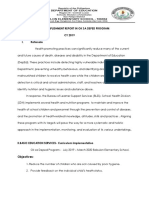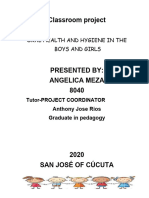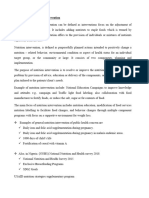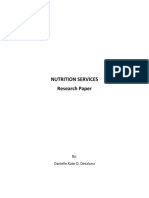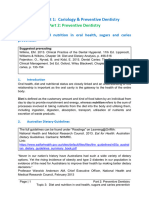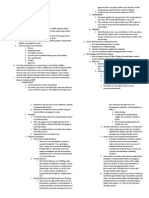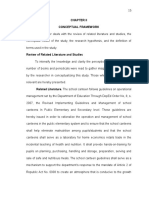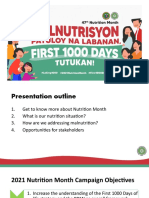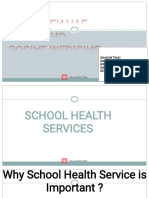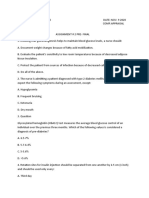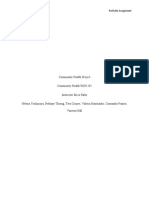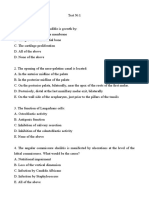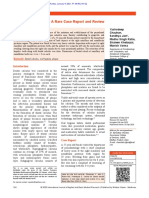0 ratings0% found this document useful (0 votes)
42 viewsBioethics New Ass 1111
Bioethics New Ass 1111
Uploaded by
Joanne Bernadette AguilarThe document discusses two programs - a nutrition program and an oral health program. The nutrition program aims to address malnutrition in the country through various strategies like food-based interventions and supplementations. It has goals of improving quality of life and reducing deficiencies. The oral health program aims to reduce tooth decay and gum disease through strategies like promoting healthy lifestyles and integrating oral health into other programs. Both programs discuss their objectives, strategies, and specific projects/activities to address important health issues in the Philippines.
Copyright:
© All Rights Reserved
Available Formats
Download as PPTX, PDF, TXT or read online from Scribd
Bioethics New Ass 1111
Bioethics New Ass 1111
Uploaded by
Joanne Bernadette Aguilar0 ratings0% found this document useful (0 votes)
42 views21 pagesThe document discusses two programs - a nutrition program and an oral health program. The nutrition program aims to address malnutrition in the country through various strategies like food-based interventions and supplementations. It has goals of improving quality of life and reducing deficiencies. The oral health program aims to reduce tooth decay and gum disease through strategies like promoting healthy lifestyles and integrating oral health into other programs. Both programs discuss their objectives, strategies, and specific projects/activities to address important health issues in the Philippines.
Original Description:
Bioethics
Copyright
© © All Rights Reserved
Available Formats
PPTX, PDF, TXT or read online from Scribd
Share this document
Did you find this document useful?
Is this content inappropriate?
The document discusses two programs - a nutrition program and an oral health program. The nutrition program aims to address malnutrition in the country through various strategies like food-based interventions and supplementations. It has goals of improving quality of life and reducing deficiencies. The oral health program aims to reduce tooth decay and gum disease through strategies like promoting healthy lifestyles and integrating oral health into other programs. Both programs discuss their objectives, strategies, and specific projects/activities to address important health issues in the Philippines.
Copyright:
© All Rights Reserved
Available Formats
Download as PPTX, PDF, TXT or read online from Scribd
Download as pptx, pdf, or txt
0 ratings0% found this document useful (0 votes)
42 views21 pagesBioethics New Ass 1111
Bioethics New Ass 1111
Uploaded by
Joanne Bernadette AguilarThe document discusses two programs - a nutrition program and an oral health program. The nutrition program aims to address malnutrition in the country through various strategies like food-based interventions and supplementations. It has goals of improving quality of life and reducing deficiencies. The oral health program aims to reduce tooth decay and gum disease through strategies like promoting healthy lifestyles and integrating oral health into other programs. Both programs discuss their objectives, strategies, and specific projects/activities to address important health issues in the Philippines.
Copyright:
© All Rights Reserved
Available Formats
Download as PPTX, PDF, TXT or read online from Scribd
Download as pptx, pdf, or txt
You are on page 1of 21
Nutrition Program
By: Joanne Bernadette C.
Aguilar
Definition
Malnutrition continues to be the public health concerns in the
country. The common nutritional deficiences are; 1.) Vitamin A,
2.) Iron , and 3.)Iodine. These deficiences lead to a serious
physical, mental, social and economic condition among children
and women.
Purposes
Nutrition program is the application of nutrition and public health
principles to design programs, systems, policies and
environments that aims to improve or maintain the optimal health
of populations and targeted groups.
It encompasses individual and interpersonal-level interventions
that create changes in knowledge, attitudes, behavior and health
outcomes among individuals, families or small targeted groups
within community setting.
Goals
To improve quality of life of Filipinos through better nutrition,
improved health and increased productivity.
Educate individuals and the public on food choices that will optimize
health and prevent disease
Monitor trends and issues in the discipline of nutrition and translate
this information into curriculum and training programs.
Apply research principles and methods to the examination of current
problems in nutrition and health.
Objectives
1. Reduction in the proportion of Filipino households with intake below
100% of the dietary energy requirement from 53.2% to 44.0%.
2. Reduction in:
a. underweight among pre school children
b. stunting among pre school children
c. chronic energy deficiency among pregnant women
d. iron deficiency among children 6 months to five years, pregnant and
lactating mothers.
e. prevalence of overweight, obesity and non-communicable diseases
f. reduction in the prevalence of iron deficiency disorder among
lactating mothers.
g. elimination of moderate and severe IDD among school
children and pregnant women
I. reduction in the prevalence of low birth weight.
Strategies
1. Food Based interventions for sustained improvements in nutritional
status
2. Life-cycle approach with strategic attention to 0-3 years old
children, adolescent females and pregnant/lactating women.
3. Effective complementation of nutrition interventions with other
services
4. Geographical focus to needier areas.
Programs and Projects
1. Micronutrient Supplementation- is one of the interventions to
address the health and nutritional needs of infants and children
and improve their growth and survival.
2. Food Fortification- is also pushed to improve the nutritional
status of the populace to include the children. The addition of
essential nutrients to a widely consumed food product at levels
above its natural state is a cost effective and sustainable
intervention to address micronutrient deficiences.
3. Essential Maternal and Child Health Service Package- This
ensures the right of the child to survival, development,
protection and participation. It includes the delivery of essential
maternal and child health and nutrition package of services that
will ensure the right to survival, development, protection and
participation as follows:
Breast feeding
Complementary feeding
Micronutrient supplementation
4. Nutrition information, communication and education – these
includes the promotion to nutritional guidelines for Filipinos and
other nutrition key messages and training of health workers.
5. Home, School and Community Food Production – It includes
establishment of Kitchens, gardens in homes, school and in
communities in urban and rural areas to serve as source of
additional food for the home and establishment of
demonstration centers and nurseries and distribution of planting
materials.
6. Food Assistance includes center based complementary
feeding for wasted/stunted children and pregnant women with
delivering lown birthweight. This may be done in school.
Rice distribution is done in school through the efforts of local
units. Food discounts were provided through Tindahan Natin
Program.
7. Livelihood Assistance is done by provision of credit and
livelihood opportunities to poor households especially those
with malnourished children through linkage with lending and
financial institutions. Functional literacy training helps in this
endeavor.
Activities
Kitchen garden, school garden and community garden set up to
promote the concept of balanced diet, as well as to increase
production
Supplementary feeding through local food production was given
to vulnerable pregnant and lactic mother and children
Food safety and hygiene
Providing better seeds as well as bred cattle
Oral Health Program
Definition
In the Philippines, the main oral health problems are dental
caries(tooth decay) and periodontal disease(gum disease).
These two diseases are widespread that 92% of our people are
suffering from tooth decay and 78.0% have gum disease.
Purposes
Help community to prevent gum disease and tooth decay.
To keep mouth healthy
Help community to attain and maintain oral health, making an
important contribution to your overall health.
Goal
Reduce the prevalence rate of dental caries and periodontal
diseases.
Objectives
1. To increase the proportion of Orally Fit Children under 6
years old
2. To control oral health risks among the young people.
3. To improve the oral health conditions of pregnant women
Strategies
Reducing oral disease burden and disability, especially in poor
and marginalized populations.
Promoting healthy lifestyles and reducing risk factors to oral
health that arise from environmental, economic, social and
behavioral causes.
Developing oral health systems that equitably improve oral
health outcomes, respond to people’s legitimate demands, and
are financially fair
Framing policies in oral health, based on integration of oral
health into national and community health programs, and
promoting oral health as an effective dimension for
development policy of society.
Programs and Projects
Oral Examination – is the careful checking of the oral cavity by
duly trained dentist to detect and diagnose oral diseases and
conditions, oral examinations, and detect signs and symptoms
of Sexually Transmitted Disease-AIDS and other non
communicable diseases such as diabetes.
Oral hygiene- is a basic personal measure to prevent and
control tooth decay and gum disease. It includes among others
oral prophylaxis, regular and proper way of tooth brushing, gum
massage, eating detersive foods and the use of mouthwashes
Pit and fissure sealant program- a non invasive preventive and
control measure against tooth decay for children. Flouride
therapy is best for smooth surfaces but limited where grinding
surfaces are concerned owing to the presence of pit and
fissures on the surfaces.
Flouride Utilization Program – a non invasive and control
measures through multiple use of flourides in areas where
flouride content is low. Flouridation can be done in systemic and
local route.
Activities
Permanent filling which is the restoration of savable teeth with
amalgam, composite or glass filling materials
Gum treatment is the deep scaling and root planning of affected
tooth or teeth for pregnant mothers and older person with
periodontal disease.
A traumatic restorative treatment is one form of permanent
filling for priority target groups by manually cleaning dental
cavities using hand instruments and filling the cavities with
flouride releasing glass ionomer restorative materials.
Temporary filling is the treatment of deep seated tooth decay
with zinc oxide and eugenol
Extraction is the removal of unsavable teeth to control foci of
infection
Treatment of post extraction complication such as dry sockets
and bleeding
Drainage of localized oral abcesses-incision and drainage.
You might also like
- Cawson S Essentials of Oral Pathology and Oral MedicineDocument565 pagesCawson S Essentials of Oral Pathology and Oral Medicineindah100% (10)
- UNICEF Conceptual Framework of MalnutritionDocument4 pagesUNICEF Conceptual Framework of MalnutritionAyu Putri Noviyanti100% (2)
- CHAPTER 13 The Role of Dental Calculus and Other Local Predisposing FactorsDocument3 pagesCHAPTER 13 The Role of Dental Calculus and Other Local Predisposing FactorsFarahNo ratings yet
- The Clinical, Microbial, and Host Response Characteristics of The Failing ImplantDocument19 pagesThe Clinical, Microbial, and Host Response Characteristics of The Failing ImplantMedstudNo ratings yet
- 1 Public Health Level of PreventionDocument38 pages1 Public Health Level of Preventionmrbyy619No ratings yet
- PHN The Phil - Nut.progDocument21 pagesPHN The Phil - Nut.progDaniela Kate Separez SimbajonNo ratings yet
- JSD 13 25Document3 pagesJSD 13 25dentistammyNo ratings yet
- Micronutrient Program: PGI Ebarle, Danica PGI Trinidad, Precious BDocument10 pagesMicronutrient Program: PGI Ebarle, Danica PGI Trinidad, Precious BPrecious TrinidadNo ratings yet
- Infant Oral Health Care BabuDocument85 pagesInfant Oral Health Care Babucoolprats_25No ratings yet
- Accomplishment Report in Ok Sa Deped Program: ObjectivesDocument6 pagesAccomplishment Report in Ok Sa Deped Program: Objectiveskristine arnaizNo ratings yet
- National Oral Health ProgramDocument21 pagesNational Oral Health ProgramScribdTranslationsNo ratings yet
- Kurukshetra August 2023 f0f9b350d6Document17 pagesKurukshetra August 2023 f0f9b350d6mydogpilluNo ratings yet
- Public Health NutritionDocument14 pagesPublic Health NutritionKhushiNo ratings yet
- The Role of Oral Helth PromotionDocument11 pagesThe Role of Oral Helth PromotionElena GrigoriuNo ratings yet
- ALMOST ORAL HEALTH AND HYGIENE Classroom ProjectDocument31 pagesALMOST ORAL HEALTH AND HYGIENE Classroom ProjectScribdTranslationsNo ratings yet
- Management of Childhood IllnessesDocument4 pagesManagement of Childhood IllnessesAnaliza GayoNo ratings yet
- School Oral Health ProgramDocument82 pagesSchool Oral Health ProgramSonal Kale100% (1)
- Public Health Nutrition InterventionDocument9 pagesPublic Health Nutrition Interventionpdsth7mtsjNo ratings yet
- Intro Oral HealthDocument10 pagesIntro Oral HealthPrincess Gutierrez RositaNo ratings yet
- Macro EconomicsDocument4 pagesMacro EconomicsAmnaNo ratings yet
- Nutrition Services Research-DesalunaDocument8 pagesNutrition Services Research-DesalunaKate Danielle DesalunaNo ratings yet
- SocSc 13 Individual Analysis PaperDocument6 pagesSocSc 13 Individual Analysis PaperSofia IntingNo ratings yet
- National Nutrition Policy For Ghana SummaryDocument4 pagesNational Nutrition Policy For Ghana SummarymailjoeyjayNo ratings yet
- Review On CHNDocument8 pagesReview On CHNAnnalisa TellesNo ratings yet
- School Health ProgramDocument6 pagesSchool Health ProgramManolin100% (1)
- Programmes Related To Child Health and WelfareDocument40 pagesProgrammes Related To Child Health and WelfareAleena ShibuNo ratings yet
- Notes - Preventive Dentistry Topic 3 - Diet and Nutrition in Oral Health, Sugars and Caries PreventionDocument24 pagesNotes - Preventive Dentistry Topic 3 - Diet and Nutrition in Oral Health, Sugars and Caries Preventiongigibis2No ratings yet
- Key+Issues+H.educDocument11 pagesKey+Issues+H.educkookie dmeowNo ratings yet
- Doh ProgramsDocument51 pagesDoh ProgramsDhaneanne Marie ChanNo ratings yet
- #Community NutritionDocument23 pages#Community Nutritionأحمد سعيد النكلاويNo ratings yet
- Malnutrition:: The Undying Illness of The PhilippinesDocument15 pagesMalnutrition:: The Undying Illness of The PhilippinesMaria NathaliaNo ratings yet
- Competency Appraisal On Community Health NursingDocument5 pagesCompetency Appraisal On Community Health NursingLea TanNo ratings yet
- Creating Mass Movement To Address MalnutritionDocument17 pagesCreating Mass Movement To Address MalnutritionCHAITI CHAKRABORTYNo ratings yet
- INCORPORATING NUTRITIONAL OBJECTIVES INTO DEVELOPMENT POLICIES AND PROGRAMSDocument7 pagesINCORPORATING NUTRITIONAL OBJECTIVES INTO DEVELOPMENT POLICIES AND PROGRAMSHabib WahabNo ratings yet
- NUTRITIONDocument15 pagesNUTRITIONmohantyashu98No ratings yet
- School Dental Health Programme Pedo 2Document25 pagesSchool Dental Health Programme Pedo 2misdduaaNo ratings yet
- Dietary Counseling and Education in Preventive Dentistry: PreventionDocument8 pagesDietary Counseling and Education in Preventive Dentistry: PreventionHaider F YehyaNo ratings yet
- Tmi 13036Document14 pagesTmi 13036unaNo ratings yet
- DessieDocument10 pagesDessieLemma BerisoNo ratings yet
- Comm-Org (G1)Document15 pagesComm-Org (G1)Jollibeth GanteNo ratings yet
- Jonalyn Chapter 2 Edited 2 22Document34 pagesJonalyn Chapter 2 Edited 2 22evangeline san jose100% (1)
- Rajiv Gandhi University of Health Sciences Bangalore, KarnatakaDocument27 pagesRajiv Gandhi University of Health Sciences Bangalore, Karnatakasathyasai999No ratings yet
- Nutrition Month PPT As of 16 June 2021Document32 pagesNutrition Month PPT As of 16 June 2021Christy ParinasanNo ratings yet
- Artikel 238Document6 pagesArtikel 238puteri asyaNo ratings yet
- School Oral Health ProgramDocument24 pagesSchool Oral Health ProgramRinku Roshan100% (1)
- Strategy: Roadmap For Nutrition in South Africa 2013-2017Document50 pagesStrategy: Roadmap For Nutrition in South Africa 2013-2017Laura Lopez GonzalezNo ratings yet
- Bibliography Palad, J - Pico PDFDocument8 pagesBibliography Palad, J - Pico PDFnicole ashley picoNo ratings yet
- Preventive Preventive AND AND Social Medicine Social MedicineDocument23 pagesPreventive Preventive AND AND Social Medicine Social MedicineShagun TyagiNo ratings yet
- Anticipatory Guidance in Pediatric Dentistry: Cite This PaperDocument6 pagesAnticipatory Guidance in Pediatric Dentistry: Cite This PaperAmanda HuggetNo ratings yet
- GEMMW Graph Theory (GROUP 4)Document6 pagesGEMMW Graph Theory (GROUP 4)Jenn TajanlangitNo ratings yet
- Ajol File Journals - 110 - Articles - 75606 - Submission - Proof - 75606 1309 172008 1 10 20120413Document18 pagesAjol File Journals - 110 - Articles - 75606 - Submission - Proof - 75606 1309 172008 1 10 20120413Md UmerNo ratings yet
- Own ManuscriptDocument8 pagesOwn Manuscriptfrancis esmaNo ratings yet
- Pediatric Dentistry A Guide For General Practitioner: February 2012Document19 pagesPediatric Dentistry A Guide For General Practitioner: February 2012Basma AminNo ratings yet
- Diet CounsellingDocument11 pagesDiet CounsellingDrBhawna AroraNo ratings yet
- Tlisk - Ci-Viii-D - RND - Group-D - Nutrition Problems and Programs in IndiaDocument8 pagesTlisk - Ci-Viii-D - RND - Group-D - Nutrition Problems and Programs in IndiaHorse ridersNo ratings yet
- Berana Thesis Chapter 1-2Document44 pagesBerana Thesis Chapter 1-2Maricel Tiongson PiccioNo ratings yet
- Child Health and Development Strategic Plan Year 2001Document5 pagesChild Health and Development Strategic Plan Year 2001Piao Liang JingNo ratings yet
- Millennium Development Goals: Goal 1 Goal 2 Goal 3 Goal 4 Goal 5 Goal 6 Goal 7Document7 pagesMillennium Development Goals: Goal 1 Goal 2 Goal 3 Goal 4 Goal 5 Goal 6 Goal 7Jeremy GarciaNo ratings yet
- Peran Pendidikan Kesehatan Gigi & Mulut Di Lingkungan SekolahDocument9 pagesPeran Pendidikan Kesehatan Gigi & Mulut Di Lingkungan Sekolah2250161138anggiNo ratings yet
- NSTP Project ProposalDocument6 pagesNSTP Project Proposalrichard allen fulladoNo ratings yet
- National Nutrition Programm and PolicyDocument15 pagesNational Nutrition Programm and PolicyDr.ekta singh chauhan100% (1)
- Family Nutrition GuideFrom EverandFamily Nutrition GuideNo ratings yet
- Childhood Obesity: Causes, Consequences and Prevention ApproachesFrom EverandChildhood Obesity: Causes, Consequences and Prevention ApproachesNo ratings yet
- Summary of Findings, Conclusion and Recommendatiojn: The ProblemDocument10 pagesSummary of Findings, Conclusion and Recommendatiojn: The ProblemJoanne Bernadette AguilarNo ratings yet
- Pharmacology Nursing MnemonicsDocument23 pagesPharmacology Nursing MnemonicsJoanne Bernadette Aguilar100% (1)
- Complete Head To Toe AssessmentDocument13 pagesComplete Head To Toe AssessmentJoanne Bernadette Aguilar100% (1)
- QUIZDocument1 pageQUIZJoanne Bernadette AguilarNo ratings yet
- Be Reviewed and Tested? (10pts)Document2 pagesBe Reviewed and Tested? (10pts)Joanne Bernadette AguilarNo ratings yet
- Psychotropic MedicationsDocument37 pagesPsychotropic MedicationsJoanne Bernadette AguilarNo ratings yet
- Final Post TestDocument23 pagesFinal Post TestJoanne Bernadette AguilarNo ratings yet
- EXAMDocument2 pagesEXAMJoanne Bernadette AguilarNo ratings yet
- Review Related LiteratureDocument2 pagesReview Related LiteratureJoanne Bernadette AguilarNo ratings yet
- Philippines: Cancer Mortality ProfileDocument3 pagesPhilippines: Cancer Mortality ProfileJoanne Bernadette AguilarNo ratings yet
- Quiz 1 3 Johannah Alexis GuiloDocument14 pagesQuiz 1 3 Johannah Alexis GuiloJoanne Bernadette AguilarNo ratings yet
- Name: Glenda S, Casundo Date: Nov. 3, 2020 Course/Yr: BSN Iv Comp - Appraisal Quiz No.2Document4 pagesName: Glenda S, Casundo Date: Nov. 3, 2020 Course/Yr: BSN Iv Comp - Appraisal Quiz No.2Joanne Bernadette AguilarNo ratings yet
- GUILODocument2 pagesGUILOJoanne Bernadette AguilarNo ratings yet
- Conceptual Framework of The StudyDocument1 pageConceptual Framework of The StudyJoanne Bernadette AguilarNo ratings yet
- Name: Glenda S, Casundo Date: Nov. 3, 2020 Course/Yr: BSN Iv Comp - Appraisal Quiz No.3Document4 pagesName: Glenda S, Casundo Date: Nov. 3, 2020 Course/Yr: BSN Iv Comp - Appraisal Quiz No.3Joanne Bernadette AguilarNo ratings yet
- Name of System Laboratory/ Diagnostic Examination Short Description Normal Result Signifcance of An Abnormal ResultDocument8 pagesName of System Laboratory/ Diagnostic Examination Short Description Normal Result Signifcance of An Abnormal ResultJoanne Bernadette AguilarNo ratings yet
- Intensive Care Unit (ICU)Document6 pagesIntensive Care Unit (ICU)Joanne Bernadette AguilarNo ratings yet
- Name: Glenda S, Casundo Date: Nov. 3, 2020 Course/Yr: BSN Iv Comp - Appraisal Quiz No.1Document4 pagesName: Glenda S, Casundo Date: Nov. 3, 2020 Course/Yr: BSN Iv Comp - Appraisal Quiz No.1Joanne Bernadette AguilarNo ratings yet
- Compt - Appraisal Prelim 2 Glenda CasundoDocument19 pagesCompt - Appraisal Prelim 2 Glenda CasundoJoanne Bernadette AguilarNo ratings yet
- Hypovolemic Shock 09Document58 pagesHypovolemic Shock 09Joanne Bernadette Aguilar100% (2)
- Comp - Appraisal Pre Final Assignment 2Document32 pagesComp - Appraisal Pre Final Assignment 2Joanne Bernadette AguilarNo ratings yet
- Hypovolemic Shock BackgroundDocument55 pagesHypovolemic Shock BackgroundJoanne Bernadette AguilarNo ratings yet
- The Removable Partial Denture EquationDocument10 pagesThe Removable Partial Denture Equationapi-3710948100% (1)
- Nutrition and Oral Health PDFDocument12 pagesNutrition and Oral Health PDFArjun NarangNo ratings yet
- Lectura 1A de Ingl-S Lapso II 2024 (Respondido)Document6 pagesLectura 1A de Ingl-S Lapso II 2024 (Respondido)julianlopez70No ratings yet
- Community Health ProjectDocument15 pagesCommunity Health Projectapi-548943155No ratings yet
- Hausmann 1974Document6 pagesHausmann 1974supriya bhartiNo ratings yet
- The Role of A Specialist in PeriodontologyDocument2 pagesThe Role of A Specialist in Periodontologykevin1678No ratings yet
- 136 Detection of Localized Tooth-Related Factors That Predispose To Periodontal InfectionsDocument15 pages136 Detection of Localized Tooth-Related Factors That Predispose To Periodontal InfectionsSeba MirandaNo ratings yet
- Bun 2Document1 pageBun 2Ana CernaianuNo ratings yet
- BookDocument105 pagesBookneetika guptaNo ratings yet
- Effects of Smoking On Non-Surgical Periodontal Therapy in Patients With Periodontitis Stage III or IV, and Grade CDocument30 pagesEffects of Smoking On Non-Surgical Periodontal Therapy in Patients With Periodontitis Stage III or IV, and Grade CDiana Choiro WNo ratings yet
- ProMind ComplexDocument27 pagesProMind ComplexctgouletNo ratings yet
- Final TestDocument534 pagesFinal TestMouna Jomaa Dhifaoui0% (1)
- Effect of Splinting On Periodontal Health - A ReviewDocument4 pagesEffect of Splinting On Periodontal Health - A ReviewSweetz Viena ParamitaNo ratings yet
- Dentosphere - World of Dentistry - Periodontics MCQs - Periodontal MicrobiologyDocument13 pagesDentosphere - World of Dentistry - Periodontics MCQs - Periodontal MicrobiologyAssssssNo ratings yet
- Effect of Periodontitis and Scaling and Root Planing On Risk of Pharyngeal Cancer: A Nested Case-Control StudyDocument12 pagesEffect of Periodontitis and Scaling and Root Planing On Risk of Pharyngeal Cancer: A Nested Case-Control StudyDr.Niveditha SNo ratings yet
- SDCEP Periodontal Disease Guidance in BriefDocument19 pagesSDCEP Periodontal Disease Guidance in BriefLupu AndreeaNo ratings yet
- Japanese Apricot (Ume) : A Novel Therapeutic Approach For The Treatment of PeriodontitisDocument14 pagesJapanese Apricot (Ume) : A Novel Therapeutic Approach For The Treatment of PeriodontitisGeorgiGugicevNo ratings yet
- The 2018 AAPEFP Classification of Periodontal DiseDocument3 pagesThe 2018 AAPEFP Classification of Periodontal DiseClaudia RosalesNo ratings yet
- Dental PlaqueDocument23 pagesDental PlaqueVenu GopalNo ratings yet
- Supportive Periodontal TherapyDocument6 pagesSupportive Periodontal TherapyIris PavičićNo ratings yet
- Risk AssessmentDocument101 pagesRisk Assessmentrevu dasNo ratings yet
- Ayu304447-3680693 101326Document12 pagesAyu304447-3680693 101326satish_CJNo ratings yet
- Systemic Metronidazoleinthe Treatmentof PeriodontitisDocument6 pagesSystemic Metronidazoleinthe Treatmentof PeriodontitisRonaldo PutraNo ratings yet
- Oral Toxicity Associated With ChemotherapyDocument56 pagesOral Toxicity Associated With ChemotherapyRobertoNo ratings yet
- Open Bite Malocclusion As Predisposing Risk Factor To Promote Periodontal DiseaseDocument4 pagesOpen Bite Malocclusion As Predisposing Risk Factor To Promote Periodontal DiseaseAasaky SumiNo ratings yet
- Perio-Restorative Inter-Relationships: 8# Periodontal Lec. April 16, 2009Document10 pagesPerio-Restorative Inter-Relationships: 8# Periodontal Lec. April 16, 2009api-3827876No ratings yet
- Giant Dental Calculus: A Rare Case Report and ReviewDocument3 pagesGiant Dental Calculus: A Rare Case Report and ReviewKiyRizkikaNo ratings yet









